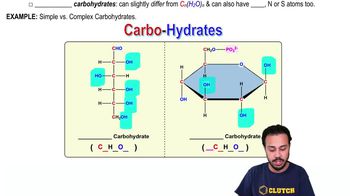Table of contents
- 1. Introduction to Biology2h 42m
- 2. Chemistry3h 40m
- 3. Water1h 26m
- 4. Biomolecules2h 23m
- 5. Cell Components2h 26m
- 6. The Membrane2h 31m
- 7. Energy and Metabolism2h 0m
- 8. Respiration2h 40m
- 9. Photosynthesis2h 49m
- 10. Cell Signaling59m
- 11. Cell Division2h 47m
- 12. Meiosis2h 0m
- 13. Mendelian Genetics4h 44m
- Introduction to Mendel's Experiments7m
- Genotype vs. Phenotype17m
- Punnett Squares13m
- Mendel's Experiments26m
- Mendel's Laws18m
- Monohybrid Crosses19m
- Test Crosses14m
- Dihybrid Crosses20m
- Punnett Square Probability26m
- Incomplete Dominance vs. Codominance20m
- Epistasis7m
- Non-Mendelian Genetics12m
- Pedigrees6m
- Autosomal Inheritance21m
- Sex-Linked Inheritance43m
- X-Inactivation9m
- 14. DNA Synthesis2h 27m
- 15. Gene Expression3h 20m
- 16. Regulation of Expression3h 31m
- Introduction to Regulation of Gene Expression13m
- Prokaryotic Gene Regulation via Operons27m
- The Lac Operon21m
- Glucose's Impact on Lac Operon25m
- The Trp Operon20m
- Review of the Lac Operon & Trp Operon11m
- Introduction to Eukaryotic Gene Regulation9m
- Eukaryotic Chromatin Modifications16m
- Eukaryotic Transcriptional Control22m
- Eukaryotic Post-Transcriptional Regulation28m
- Eukaryotic Post-Translational Regulation13m
- 17. Viruses37m
- 18. Biotechnology2h 58m
- 19. Genomics17m
- 20. Development1h 5m
- 21. Evolution3h 1m
- 22. Evolution of Populations3h 52m
- 23. Speciation1h 37m
- 24. History of Life on Earth2h 6m
- 25. Phylogeny2h 31m
- 26. Prokaryotes4h 59m
- 27. Protists1h 12m
- 28. Plants1h 22m
- 29. Fungi36m
- 30. Overview of Animals34m
- 31. Invertebrates1h 2m
- 32. Vertebrates50m
- 33. Plant Anatomy1h 3m
- 34. Vascular Plant Transport1h 2m
- 35. Soil37m
- 36. Plant Reproduction47m
- 37. Plant Sensation and Response1h 9m
- 38. Animal Form and Function1h 19m
- 39. Digestive System1h 10m
- 40. Circulatory System1h 57m
- 41. Immune System1h 12m
- 42. Osmoregulation and Excretion50m
- 43. Endocrine System1h 4m
- 44. Animal Reproduction1h 2m
- 45. Nervous System1h 55m
- 46. Sensory Systems46m
- 47. Muscle Systems23m
- 48. Ecology3h 11m
- Introduction to Ecology20m
- Biogeography14m
- Earth's Climate Patterns50m
- Introduction to Terrestrial Biomes10m
- Terrestrial Biomes: Near Equator13m
- Terrestrial Biomes: Temperate Regions10m
- Terrestrial Biomes: Northern Regions15m
- Introduction to Aquatic Biomes27m
- Freshwater Aquatic Biomes14m
- Marine Aquatic Biomes13m
- 49. Animal Behavior28m
- 50. Population Ecology3h 41m
- Introduction to Population Ecology28m
- Population Sampling Methods23m
- Life History12m
- Population Demography17m
- Factors Limiting Population Growth14m
- Introduction to Population Growth Models22m
- Linear Population Growth6m
- Exponential Population Growth29m
- Logistic Population Growth32m
- r/K Selection10m
- The Human Population22m
- 51. Community Ecology2h 46m
- Introduction to Community Ecology2m
- Introduction to Community Interactions9m
- Community Interactions: Competition (-/-)38m
- Community Interactions: Exploitation (+/-)23m
- Community Interactions: Mutualism (+/+) & Commensalism (+/0)9m
- Community Structure35m
- Community Dynamics26m
- Geographic Impact on Communities21m
- 52. Ecosystems2h 36m
- 53. Conservation Biology24m
7. Energy and Metabolism
Introduction to Metabolism
Problem 11`
Textbook Question
Explain how your body can convert excess carbohydrates in the diet to fats. Can excess carbohydrates be converted to protein? What else must be supplied?
 Verified step by step guidance
Verified step by step guidance1
Carbohydrates consumed in excess are broken down into glucose molecules during digestion. These glucose molecules enter the bloodstream and are used for immediate energy or stored as glycogen in the liver and muscles.
When glycogen storage capacity is exceeded, the excess glucose undergoes a process called glycolysis, where it is converted into pyruvate. Pyruvate is then further processed into acetyl-CoA, a key molecule in metabolic pathways.
Acetyl-CoA can enter the lipogenesis pathway, where it is used to synthesize fatty acids. These fatty acids are then combined with glycerol to form triglycerides, which are stored in adipose tissue as fat.
Excess carbohydrates cannot be directly converted into proteins because proteins are made from amino acids, which are nitrogen-containing molecules. Carbohydrates lack nitrogen, so the body cannot synthesize amino acids from carbohydrates alone. To produce proteins, the body requires a dietary source of nitrogen, typically from amino acids found in protein-rich foods.
In addition to carbohydrates, the body must have sufficient energy (ATP) and cofactors such as NADPH to drive the lipogenesis process. For protein synthesis, essential amino acids must be supplied through the diet, as the body cannot produce them on its own.
 Verified video answer for a similar problem:
Verified video answer for a similar problem:This video solution was recommended by our tutors as helpful for the problem above
Video duration:
1mPlay a video:
Was this helpful?
Key Concepts
Here are the essential concepts you must grasp in order to answer the question correctly.
Carbohydrate Metabolism
Carbohydrate metabolism involves the breakdown of carbohydrates into glucose, which is then used for energy. When there is an excess of glucose, the body can convert it into glycogen for short-term storage in the liver and muscles. Once glycogen stores are full, the body transforms excess glucose into fatty acids through a process called lipogenesis, which are then stored as fat.
Recommended video:
Guided course

Carbohydrates
Lipogenesis
Lipogenesis is the metabolic process through which excess carbohydrates are converted into fatty acids and subsequently stored as fat in adipose tissue. This process occurs primarily in the liver and adipose tissue and is stimulated by insulin, which promotes the uptake of glucose and its conversion into fat when energy needs are met.
Protein Synthesis and Nitrogen Requirement
While carbohydrates can be converted into fats, they cannot be directly converted into proteins. Protein synthesis requires amino acids, which are the building blocks of proteins. For the body to synthesize proteins, it must have an adequate supply of essential amino acids, which are obtained from dietary proteins, along with sufficient energy from carbohydrates or fats.
Recommended video:
Guided course

Nitrogen Cycle

 2:17m
2:17mWatch next
Master Introduction to Metabolism with a bite sized video explanation from Jason
Start learningRelated Videos
Related Practice










